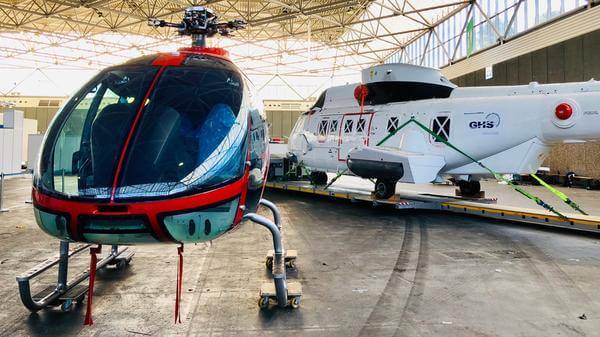Helicopter maintenance safety

Safety discussions in AirMed&Rescue usually centre on pilot training and technological advancements, but keeping the aircraft maintenance staff safe is a vital part of the safety system. Stuart McOnie, Managing Director of Semmco, reflects on the risks to maintenance personnel
Maintenance work on helicopters can either involve heavy maintenance and major inspections, or regular minor checks and repairs between flights. Irrespective of whether it is heavy, or line maintenance is required, it is important that the engineering or operations managers ensure their teams of maintenance technicians are suitability equipped for all tasks, including working at a height. Employers need to understand that even a relatively small fall from height can result in significant injury, production losses and possible fines.
The risk of injury
Every year, the Health and Safety Executive (HSE) will publish reports on workers in the aviation industry injuring themselves after falling from a height, with many incidents occurring during aircraft maintenance when entering or exiting the aircraft, when working on or from service equipment .
The types of environments in which engineering work takes place can be very different, depending on the work required and whether it occurs inside or outside the helicopter. For this reason, technicians need to consider their personal safety, no matter the setting, with management overseeing these procedures. Deep maintenance or repairs typically take place in a hangar or sheltered environment, but depending on the operation, line maintenance could be required in remote locations in perilous weather conditions with limited facilities.
The hazards involved in maintenance work on helicopters are similar to fixed-wing aircraft, including the risks associated with the non-linear shape of the aircraft and intricate maintenance tasks. Due to the frequent servicing required in keeping helicopters safe and serviceable, the exposure to hazards, such as work at height, is far higher compared to fixed-wing aircraft maintenance work. And, although helicopters tend to be smaller than many fixed-wing aircraft, the height of their rotor assemblies and mechanical parts still pose a significant risk of injury from a fall. For example, the removal and replacement of the helicopter’s major components or its assemblies can be precarious work, and the presence of rotating blades present additional risks for both access and maintenance.

Employer responsibility
Whether working at height is a one-off task, or a part of an engineer’s day-to-day routine, a risk assessment must be carried out to identify any risks associated with the task, so that suitable precautions to prevent accidents can be implemented accordingly.
In 2005, new Work at Height Regulations were introduced that placed new legal responsibilities on employers to ensure that equipment, such as ladders and platforms, used to facilitate working at any height minimised the risk of falling and offered sufficient protection to workers.
Two years later, under the Work at Height (Amendment) Regulations 2007, wherever a worker is required to work at height, the employer, manager, project supervisor, foreman or any person who controls the work of others must ensure:
- All work at height is properly planned and organised.
- Those involved in work at height are competent.
- The risks are assessed and appropriate work equipment is selected and used.
- The risks from fragile surfaces are properly controlled.
- Equipment for work at height is properly inspected and maintained.
An employer who neglects or fails to minimise risk to ensure worker safety can be found liable if any employee in their care suffers a serious injury caused when working at height
It is the employer’s duty to ensure that the access equipment is safe for its employees and other people to use. Suitable and effective measures should be taken to prevent anyone falling a distance that might cause them personal injury. In addition, employers should not allow anyone to engage in any activity in relation to work at height unless they are competent to and have undertaken sufficient training. An employer who neglects or fails to minimise risk to ensure worker safety can be found liable if any employee in their care suffers a serious injury caused when working at height.
Steps and access equipment
In the rotorcraft sector, the access requirements for engineering and refinishing can be very different. Refinishing work may require working platforms at levels not always ideal for engineering work, and the space needed between the helicopter and working platform may vary. The Health & Safety Executive (HSE) highlights that employers need to provide safe access for all purposes which requires careful planning, with access arrangements subject to change as work progresses throughout the day.
Today, the industry has a wide range of access and ground support equipment that enables engineers to conduct their maintenance work safely. The type and design of steps and access equipment depends on the size and design of the helicopter itself. Typically, larger helicopter operators should have customised access equipment to ensure the aircraft’s requirements are met, and to safeguard the engineers’ safety when working at height. The equipment used must guarantee protection while being compliant to safety standards.
12e3.jpg)
May 2019
Issue
In this issue:
- The latest advancements in eye- and face-tracking technology for pilot training
- Hoists, hooks and winches as essential parts of the SAR tool kit
- A look at Patriot South 19’s March training exercise
- A special report on the CL-415 Full Flight Simulator
Stuart McOnie
Stuart is Managing Director of Semmco, a design and engineering company offering a range of specialist services for access platforms, ground support equipment and respiratory protection systems for all areas of industry and military.
